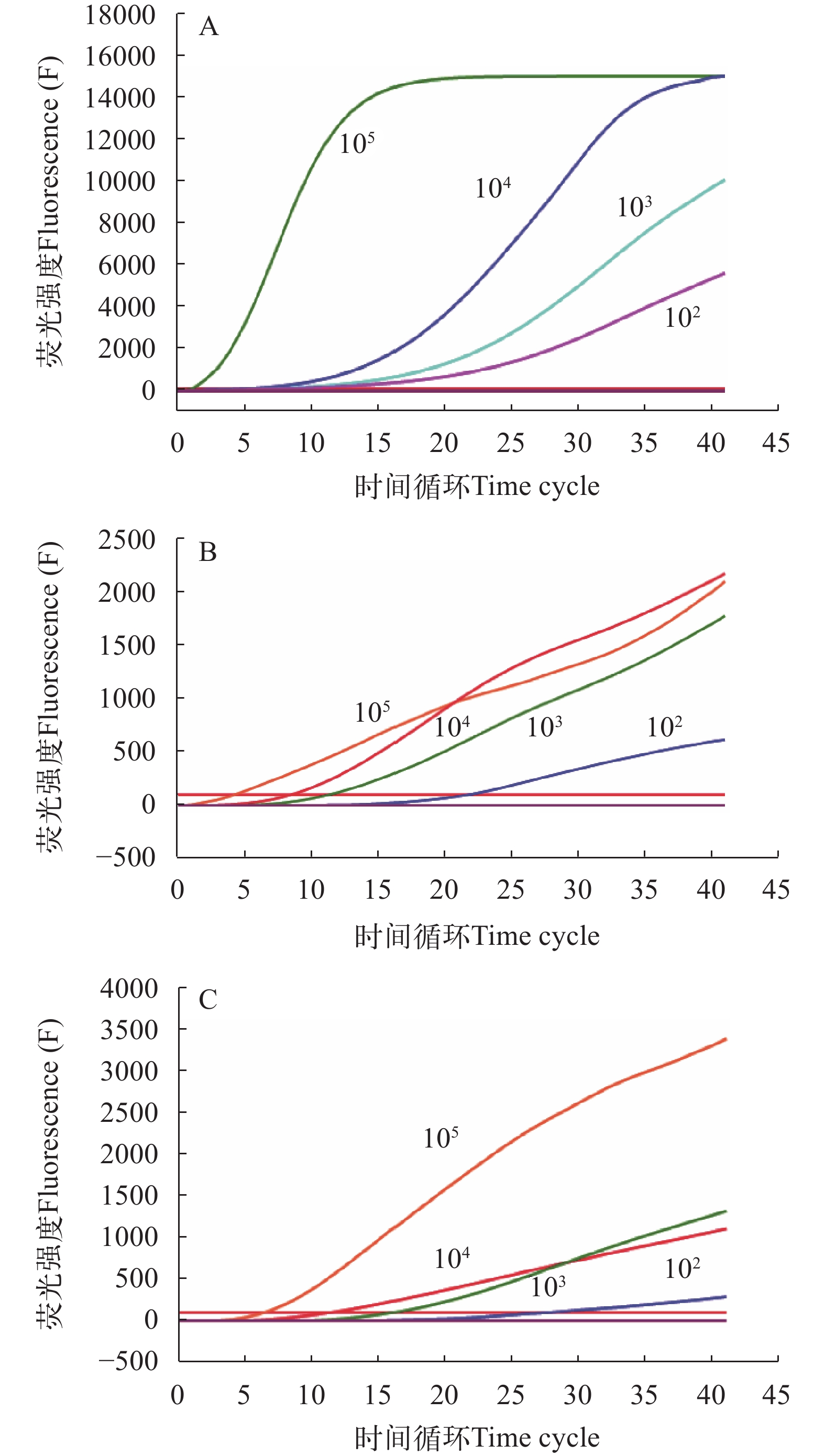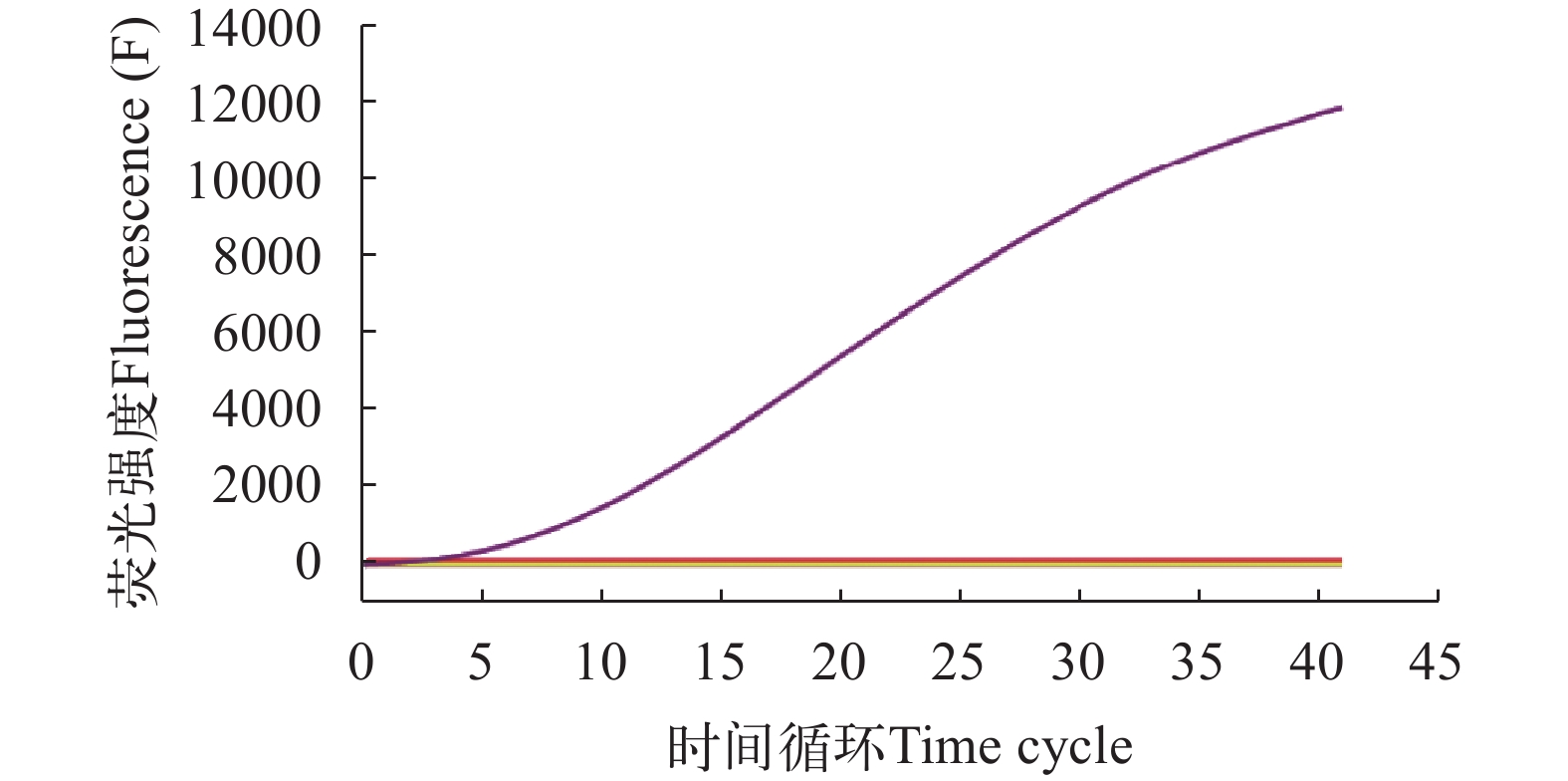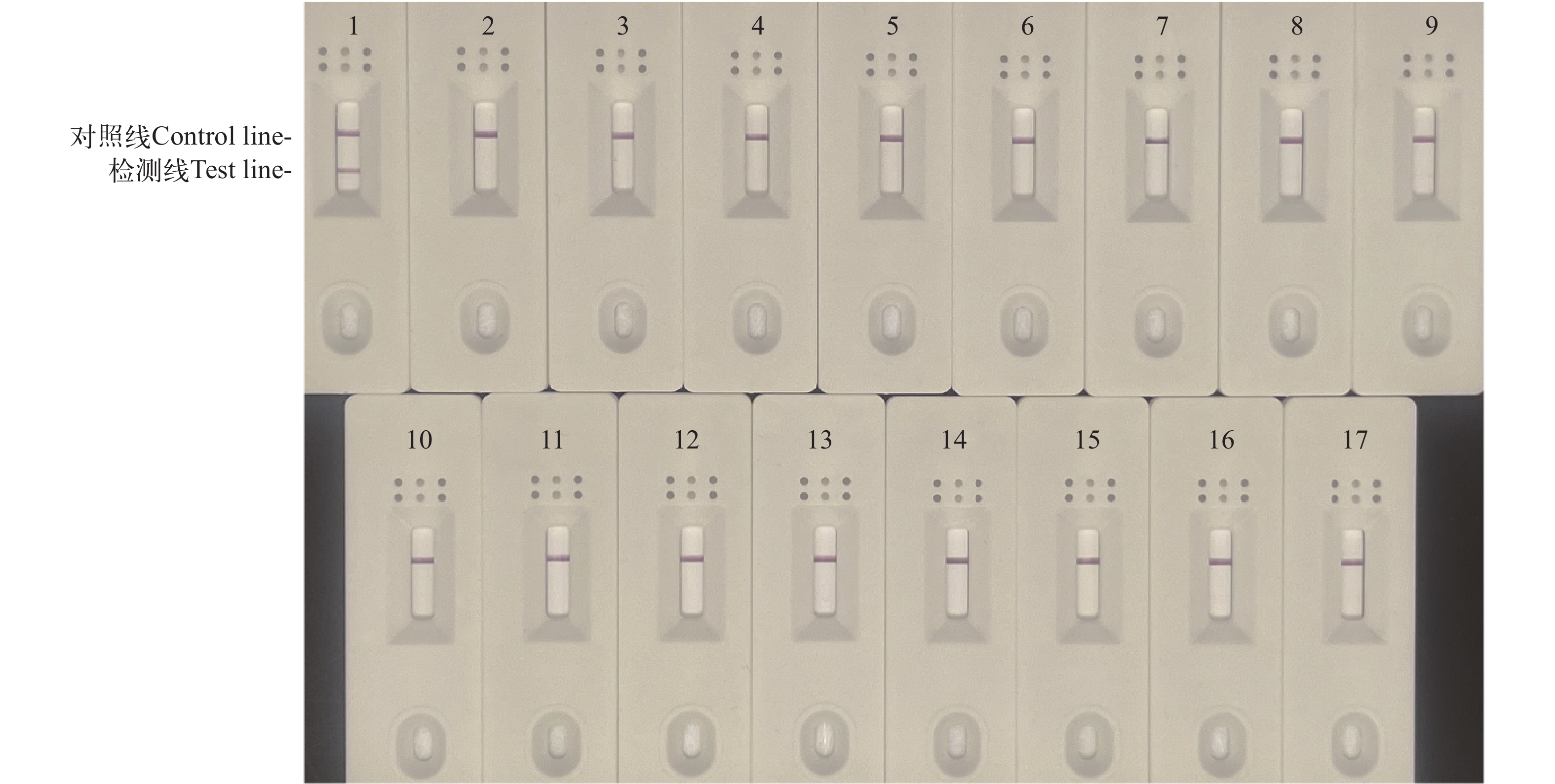DEVELOPMENT AND APPLICATION OF REAL-TIME AND LATERAL FLOW DIPSTICK RECOMBINASE POLYMERASE AMPLIFICATION ASSAYS FOR RAPID SPECIES IDENTIFICATION OF PELTEOBAGRUS FULVIDRACO
-
摘要:
研究以黄颡鱼为目标对象, 基于重组酶聚合酶扩增(Recombinase polymerase amplification, RPA)等温扩增技术, 开发了实时荧光型RPA和侧向流RPA试纸条两种现场快速检测方法。这些方法能够用于快速、准确和灵敏地实时检测出黄颡鱼DNA。首先, 通过对黄颡鱼及其近缘物种的鱼类线粒体基因组序列进行对比分析, 针对COI基因保守区域, 设计了特异性探针和引物。测试结果显示, 在37℃条件下, 实时荧光型RPA和侧向流RPA试纸条都具有良好的特异性。实时荧光型RPA方法能够在20min内完成黄颡鱼DNA的检测, 且最低检测限可以达到102拷贝数/反应; 而侧向流RPA试纸条的操作更加便捷, 能够在10min内可完成对102低拷贝数的黄颡鱼DNA的扩增和鉴定。应用这两种RPA检测技术对149份长江流域常见鱼类进行现场检测, 两种方法均显示出较高的准确性(准确率100%)。因此, 研究开发的两种用于检测黄颡鱼的实时荧光型RPA和侧向流RPA试纸条方法, 拥有操作简便、结果直观、准确率高、不依赖实验室仪器设备等优势, 具有良好的现场快速检测应用前景。此外, 其克服了形态学物种鉴定专业门槛高、难以鉴定残破组织样品的问题, 检测靶标可跨越卵、鱼苗、成鱼等全生命周期, 为水产品监管执法提供技术手段。
Abstract:In order to effectively prevent illegal fishing of wild fishery resources in the Yangtze River, it is crucial to provide technical support for the “ten-year ban on fishing in the Yangtze River” and develop methods that can quickly and accurately identify fish species on site. This study focuses on Pelteobagrus fulvidraco and utilizes isothermal amplification technology, specifically Recombinase Polymerase Amplification (RPA), to develop two rapid on-site detection methods: Real-time fluorescent RPA and lateral flow RPA test strips, which are ideally suited for the swift in-field detection of P. fulvidraco DNA. We developed an RPA assay based on either Real-time fluorescent detection (Real-time RPA assay) or lateral flow dipstick (RPA-LFD assay) for rapid, accurate, and sensitive detection of P. fulvidraco DNA, facilitating effective management of the fishing ban in the Yangtze River basin. Primers and probes for both assays were designed to target conserved regions of the mitochondrial cytochrome c oxidase subunit Ⅰ (COⅠ) gene in P. fulvidraco. Tests demonstrated that both the Real-time RPA and RPA-LFD assays exhibited good specificity at 37℃. The Real-time RPA assay achieved a detection limit of 102 copies of P. fulvidraco DNA per reaction, with amplification completed within 20min, though it requires a constant temperature amplification instrument. In contrast, the RPA-LFD assay offers a more convenient operation with a shorter amplification time of only 10min for 102 copies of P. fulvidraco DNA. Additionally, both methods were tested on 149 samples for known fish species, yielding results consistent with actual species identification. The Real-time fluorescence RPA and lateral flow dipstick RPA methods developed in this study for detecting P. fulvidraco DNA have the advantages of easy operation, intuitive results, high accuracy, and no dependence on laboratory instruments and equipment. They have good prospects for rapid on-site detection applications. In addition, it overcomes the problems of high professional threshold for morphological species identification and difficulty in identifying damaged tissue samples. The detection targets can span the entire life cycle of eggs, fish fry, and adult fish, providing essential technical support for aquatic product supervision and law enforcement.
-
-
表 1 RPA引物探针设计与序列
Table 1 Primers and probes sequences
名称Name 基因序列Sequence (5′—3′) P. fulvidraco-Fe TCGTCGTGGCATGCCAGCTAAGCCTAGGAAGTG P. fulvidraco-Re CGTATTTGCCATCATAGGAGCCTTCGTACACTG P. fulvidraco-Pe CCAAAGTGGATTTTTGTTCAGGTGTCATGTA/i6FAMdT/T/idSp//iBHQ1dT/ATAGCCCGTAAATAG/iSpC3/ P. fulvidraco-Rn 5′Biotin-CTTCCACTACGTCTTATCAATGGGGGCCGTAT P. fulvidraco-Pn 5′FAM-TGTATAGCCCGTAAATAGGGGGAATCAGTGT[THF]ACGAAGGCTCCTATG-3′C3 Spacer 表 2 实时荧光型RPA和侧向流RPA试纸条对鱼类样本的检测结果
Table 2 Detection results of fish samples by Real-time fluorescent RPA and RPA-LFD assay
鱼类样本Fish sample 样品数Sample quantity 荧光RPA检测结果Results of Real-time fluorescent RPA 侧向流RPA试纸条检测结果Results of RPA-LFD assay 黄颡鱼Pelteobagrus fulvidraco 14 + + 长须黄颡鱼Pelteobagrus eupogon 6 - - 瓦氏黄颡鱼Pelteobagrus vachellii 6 - - 光泽黄颡鱼Pelteobaggrus nitidus 6 - - 鲢Hypophthalmichthys molitrix 20 - - 鳙Hypophthalmichthys Nobilis 14 - - 青鱼Mylopharyngodon piceus 6 - - 草鱼Ctenopharyngodon idella 12 - - 刀鲚Coilia nasus 7 - - 短额鲚Coilia brachygnathus 6 - - 鳜Siniperca chuatsi 14 - - 大眼鳜Siniperca knerii 6 - - 翘嘴鲌Culter alburnus 14 - - 达氏鲌Chanodichthys dabryi 6 - - 蒙古鲌Chanodichthys mongolicus 6 - - 红鳍原鲌Culter erythropterus 6 - - 注: “+”代表检测结果阳性, “-”代表检测结果阴性 Note: “+” represent the positive results, “-” represent the negative results. -
[1] 王令玲, 仇潜如, 邹世平, 等. 黄颡鱼生物学特点及其繁殖和饲养 [J]. 淡水渔业, 1989, 19(6): 23-24,31.] Wang L L, Qiu Q R, Zou S P, et al. Biological characteristics, reproduction and feeding of Pelteobagrus fulvidraco [J]. Freshwater Fisheries, 1989, 19(6): 23-24,31. [
[2] 刘世平. 鄱阳湖黄颡鱼生物学研究 [J]. 动物学杂志, 1997, 32(4): 11-17.] Liu S P. A study on the biology of Pseudobagrus fulvidraco in Poyang Lake [J]. Chinese Journal of Zoology, 1997, 32(4): 11-17. [
[3] 张滕闲, 陈钱, 张宝龙, 等. 姜黄素对黄颡鱼(Pelteobagrus fulvidraco)生长、消化与抗氧化能力的影响 [J]. 渔业科学进展, 2017, 38(6): 56-63.] doi: 10.11758/yykxjz.20161009001 Zhang T X, Chen Q, Zhang B L, et al. The effects of curcumin on the growth, digestion and antioxidant ability of yellow catfish (Pelteobagrus fulvidraco) [J]. Progress in Fishery Sciences, 2017, 38(6): 56-63. [ doi: 10.11758/yykxjz.20161009001
[4] 李大命, 刘洋, 刘燕山, 等. 基于线粒体Ctyb基因的滆湖3种黄颡鱼遗传多样性分析 [J]. 安徽农业科学, 2023, 51(21): 105-108,121.] doi: 10.3969/j.issn.0517-6611.2023.21.024 Li D M, Liu Y, Liu Y S, et al. Genetic diversity of three species of pelteobagrus in Ge Lake based on Cytb gene sequence [J]. Journal of Anhui Agricultural Sciences, 2023, 51(21): 105-108,121. [ doi: 10.3969/j.issn.0517-6611.2023.21.024
[5] 钟立强, 陈校辉, 蔡永祥, 等. 黄颡鱼DNA分子标记的研究进展 [J]. 中国农学通报, 2012, 28(5): 67-75.] doi: 10.3969/j.issn.1000-6850.2012.05.014 Zhong L Q, Chen J H, Cai Y X, et al. Research progress in DNA molecular markers of yellow catfish Pelteobagrus fulvidraco [J]. Chinese Agricultural Science Bulletin, 2012, 28(5): 67-75. [ doi: 10.3969/j.issn.1000-6850.2012.05.014
[6] 郑光明, 朱新平, 张跃. 鱼类种质鉴定技术与渔业管理 [J]. 中国水产科学, 1999, 6(2): 108-111.] doi: 10.3321/j.issn:1005-8737.1999.02.026 Zheng G M, Zhu X P, Zhang Y. A technique of fish germplasm identification and its application in fishery management [J]. Journal of Fishery Sciences of China, 1999, 6(2): 108-111. [ doi: 10.3321/j.issn:1005-8737.1999.02.026
[7] 董志国, 常玉梅. 鱼类种质鉴定的主要技术与方法 [J]. 水产学杂志, 2002, 15(2): 74-77.] doi: 10.3969/j.issn.1005-3832.2002.02.017 Dong Z G, Chang Y M. Identical techniques and ways on fish germplasm [J]. Chinese Journal of Fisheries, 2002, 15(2): 74-77. [ doi: 10.3969/j.issn.1005-3832.2002.02.017
[8] 刘绍平, 段辛斌, 陈大庆, 等. 长江中游渔业资源现状研究 [J]. 水生生物学报, 2005, 29(6): 708-711.] doi: 10.3321/j.issn:1000-3207.2005.06.019 Liu S P, Duan X B, Chen D Q, et al. Studies on status of fishery resources in the middle reach of the Yangtze river [J]. Acta Hydrobiologica Sinica, 2005, 29(6): 708-711. [ doi: 10.3321/j.issn:1000-3207.2005.06.019
[9] 湖南: 湖南农业大学, 2008. [杨昌珍. 鲫鱼的几种种质鉴定方法的比较研究 [D]. 2008.] Yang C Z. Comparison research about several a variety of quality of crucian identifies method [D].
[10] 李渊. 鲳属鱼类形态学和遗传学研究 [D]. 青岛: 中国海洋大学, 2015.] Li Y. Studies on morphology and genetics of Pampus species [D]. Qingdao: Ocean University of China, 2015. [
[11] 舒汉鼎. 黄颡鱼属分子标记鉴定 [D]. 江西: 南昌大学, 2014.] Shu H D. Identification of molecular marker in Pelteobagrus [D]. Nanchang: Nanchang University, 2014. [
[12] 童芳芳, 汤明亮, 杨星, 等. 用RAPD和SCAR复合分子标记对黄颡鱼属进行种质鉴定 [J]. 水生生物学报, 2005, 29(4): 465-468.] doi: 10.3321/j.issn:1000-3207.2005.04.020 Tong F F, Tang M L, Yang X, et al. Species authentication of Pelteobagrus by multiplex molecular marker papd and scar [J]. Acta Hydrobiologica Sinica, 2005, 29(4): 465-468. [ doi: 10.3321/j.issn:1000-3207.2005.04.020
[13] 岳佐和. 广西淡水鱼类志 [M]. 南宁: 广西人民出版社, 1981: 187-188.] Yue Z H, et al. Fresh Water Fishes of Guangxi [M]. Nanning: Guangxi People Press, 1981: 187-188. [
[14] 毛荣节. 浙江动物志(淡水鱼类) [M]. 杭州: 浙江科学出版社, 1991: 158-159.] Mao R J, et al. Fauna of Zhejiang (Division of Fresh Water Fishes) [M]. Hangzhou Zhejiang Science Press, 1991: 158-159. [
[15] 申雪艳. 孔雀鱼微卫星DNA标记的研制及其遗传连锁图谱的构建 [D]. 青岛: 中国海洋大学, 2007.] Shen X Y. Development of genomic microsatellite DNA markers and construction of genetic linkage map of guppy (Poecilia reticulata) based on AFLP and SSR markers [D]. Qingdao: Ocean University of China, 2007. [
[16] 宋威, 张芹, 李桂玲, 等. RAPD分子标记技术在鱼类研究中的应用进展 [J]. 河南水产, 2009(2): 9-10.] Song W, Zhang Q, Li G L, et al. Application progress of RAPD molecular marker technology in fish research [J]. Henan Fisheries, 2009(2): 9-10. [
[17] 罗伟. 团头鲂EST-SSR的开发及在育种中的应用[D]. 武汉: 华中农业大学, 2014.] Luo W. EST-SSR markers development and application in selective breeding of bluntsnout breammegahbrama amblycephala [D]. Wuhan: Huazhong Agricultural University, 2014. [
[18] 吕继洲, 袁向芬, 林祥梅, 等. 饲料用鱼类、哺乳类及禽类源性成分三重TaqMan-MGB荧光PCR检测方法的建立及应用 [J]. 质量安全与检验检测, 2023, 33(3): 16-24.] LV J Z, Yuan X F, Lin X M, et al. Establishment and application of a Triple TaqMan-MGB fluorescent PCR detection method for fish, mammal and avian derived materials in feeds [J]. Quality Safety Inspection and Testing, 2023, 33(3): 16-24. [
[19] 余明芬, 曾洪梅, 张桦, 等. 微流控芯片技术研究概况及其应用进展 [J]. 植物保护, 2014, 40(4): 1-8.] doi: 10.3969/j.issn.0529-1542.2014.04.001 Yu M F, Zeng H M, Zhang H, et al. Research progress in microfluidics and its applications [J]. Plant Protection, 2014, 40(4): 1-8. [ doi: 10.3969/j.issn.0529-1542.2014.04.001
[20] 詹成, 燕丽, 王琳, 等. 数字PCR技术的发展和应用 [J]. 复旦学报(医学版), 2015, 42(6): 786-789.] Zhan C, Yan L, Wang L, et al. The development and application of digital PCR [J]. Fudan University Journal of Medical Sciences, 2015, 42(6): 786-789. [
[21] Piepenburg O, Williams C H, Stemple D L, et al. DNA detection using recombination proteins [J]. PLoS Biology, 2006, 4(7): e204.
[22] Boyle D S, McNerney R, Teng Low H, et al. Rapid detection of Mycobacterium tuberculosis by recombinase polymerase amplification [J]. PLoS One, 2014, 9(8): e103091. doi: 10.1371/journal.pone.0103091
[23] 王慧芳, 喻勇新, 李晨虹, 等. 重组酶聚合酶扩增反应结合侧流层析试纸条技术快速鉴别大西洋鳕鱼制品真伪 [J]. 食品与发酵工业, 2022, 48(17): 291-297.] Wang H F, Yu Y X, Li C H, et al. Real-time characterization of Atlantic cod by recombinase polymerase amplification coupled lateral flow dipstick (RPA-LFD) [J]. Food and Fermentation Industries, 2022, 48(17): 291-297. [
[24] 陈雨, 郑晓聪, 温智清, 等. 病毒性出血败血症病毒实时荧光RT-RPA恒温检测方法的建立 [J]. 中国兽医科学, 2020, 50(4): 417-422.] Chen Y, Zheng X C, Wen Z Q, et al. Development of a RT-RPA assay for rapid detection of viralhemorrhagic septicemia virus [J]. Chinese Veterinary Science, 2020, 50(4): 417-422. [
[25] 四川: 四川农业大学, 2020. [蒋玉涵. 三种鱼类病毒CyHV-2、KHV、GCRV的RPA快检方法研究 [D]. 2020.] Jiang Y H. Recombinase polymerase amplification assaysfor rapid detection of three fish viruses CyHV2, KHV, GCRV [D].
[26] 陈颖, 于宁, 彭涛, 等. 现场执法食品安全快速检测产品研发与应用 [J]. 质量安全与检验检测, 2023, 33(1): 46-52.] Chen Y, Yu N, Peng T, et al. Development and application of rapid testing of food safety on site law enforcement [J]. Quality Safety Inspection and Testing, 2023, 33(1): 46-52. [
[27] 杨利娟. 食品安全快速检测对农贸市场监管的意义探究 [J]. 食品安全导刊, 2022(35): 17-20.] doi: 10.3969/j.issn.1674-0270.2022.35.spaqdk202235021 Yang L J. Probe into the significance of rapid food safety inspection on the supervision of farmers’ markets [J]. China Food Safety Magazine, 2022(35): 17-20. [ doi: 10.3969/j.issn.1674-0270.2022.35.spaqdk202235021
[28] 成庆泰, 郑葆珊. 中国鱼类系统检索(上册) [M]. 北京: 科学出版社, 1987: 213-214.] Cheng Q T, Zheng B S. Systematic Retrieval of Fish in China [M]. Beijing: Science Press, 1987: 213-214. [
[29] 杨干荣. 湖北鱼类志 [M]. 武汉: 湖北科学技术出版社, 1987: 159-165.] Yang G R. Fishes of Hubei [M]. Hubei: Hubei Science and Tech2 nology Press. 1987: 159-165. [
[30] 毛慧玲, 赵哲霞, 舒汉鼎, 等. 鄱阳湖4种黄颡鱼形态差异分析[J]. 安徽农业大学学报, 2014, 41(5): 793-797.] Mao H L, Zhao Z X, Shu H D, et al. Morphological variations in four Pelteobagrus species in Poyang Lake [J]. Journal of Anhui Agricultural University, 2014, 41(5): 793-797. [
[31] 库喜英, 周传江, 何舜平. 中国黄颡鱼的线粒体DNA多样性及其分子系统学 [J]. 生物多样性, 2010, 18(3): 262-274.] doi: 10.3724/SP.J.1003.2010.262 Ku X Y, Zhou C J, He S P. Validity of Pseudobagrus sinensis and mitochondrial DNA diversity of Pseudobagrus fulvidraco populations in China [J]. Biodiversity Science, 2010, 18(3): 262-274. [ doi: 10.3724/SP.J.1003.2010.262
[32] 巩高瑞, 张晋, 丹成, 等. 应用DNA分子标记鉴定黄颡鱼、瓦氏黄颡鱼及其杂交种的研究 [J]. 水生生物学报, 2017, 41(2): 321-325.] doi: 10.7541/2017.39 Gong G R, Zhang J, Dan C, et al. Identification of Pelteobagrus fulvidraco, Pelteobaggrus vachelli and their interspecific hybrid by DNA markers [J]. Acta Hydrobiologica Sinica, 2017, 41(2): 321-325. [ doi: 10.7541/2017.39
[33] 赵文学, 杨星, 彭智, 等. 黄颡鱼属物种的RAPD分子鉴定及杂种遗传分析 [J]. 水生生物学报, 2006, 30(1): 101-106.] doi: 10.3321/j.issn:1000-3207.2006.01.019 Zhao W X, Yang X, Peng Z, et al. Molecular identification of the four species of the genus Pelteobagrus and the genetic analysis of their hybrid [J]. Acta Hydrobiologica Sinica, 2006, 30(1): 101-106. [ doi: 10.3321/j.issn:1000-3207.2006.01.019
[34] 赵新宁. DNA条形码和eDNA技术在鱼类分类鉴定中的应用 [D]. 上海: 上海海洋大学, 2022.] Zhao X N. Application of DNA barcode and eDNA technology in fish classification and identification [D]. Shanghai: Shanghai Ocean University, 2022. [
[35] Liu Y, Huang H, Zheng Y, et al. Development of a POCT detection platform based on a locked nucleic acidenhanced ARMS-RPA-GoldMag lateral flow assay [J]. Journal of Pharmaceutical and Biomedical Analysis, 2023(235): 115632.
[36] Chan K, Wong P Y, Parikh C, et al. Moving toward rapid and low-cost point-of-care molecular diagnostics with a repurposed 3D printer and RPA [J]. Analytical Biochemistry, 2018(545): 4-12. doi: 10.1016/j.ab.2018.01.008
[37] 侯梦媛, 张铁男, 白无忌. 可视化牛传染性鼻气管炎病毒快速检测 [J/OL]. 微生物学通报, 2024: 1-14.] Hou M Y, Zhang T N, Bai W j. A visual rapid detection method for bovine infectious rhinotracheitis virus [J/OL]. Microbiology China, 2024: 1-14. [
[38] 孙雯君, 黄行许, 王鑫杰. 基于CRISPR的快速灵敏便捷分子检测 [J]. 生物工程学报, 2023, 39(1): 60-73.] Sun W J, Huang X X, Wang X J. CRlSPR-based molecular diagnostics: a review [J]. Chinese Journal of Biotechnology, 2023, 39(1): 60-73. [
[39] 林而舒. 鳗鲡疱疹病毒基础RPA及RPA-LFD检测方法的比较 [J]. 渔业研究, 2024, 46(4): 367-374.] Lin E S. Comparison of basic RPA and RPA-LFD assays for Anguillid herpesvirus [J]. Journal of Fisheries Research, 2024, 46(4): 367-374. [
[40] 包涛涛, 杨先富, 廖飞, 等. RPA检测技术在禽源病原检测中的研究进展 [J]. 中国畜牧兽医, 2024, 51(2): 482-490.] Bao T T, Yang X F, Liao F, et al. Research progress of RPA detection technology in the detection of avian pathogens [J]. China Animal Husbandry & Veterinary Medicine, 2024, 51(2): 482-490. [
[41] 魏梅生, 田茜, 赵文军, 等. 番茄细菌性叶斑病菌RPA检测技术 [J]. 植物保护, 2016, 42(1): 150-153.] doi: 10.3969/j.issn.0529-1542.2016.01.027 Wei M S, Tian Q, Zhao W J, et al. Rapid detection of Pseudomonas syringae pv. tomato by RPA method [J]. Plant Protection, 2016, 42(1): 150-153. [ doi: 10.3969/j.issn.0529-1542.2016.01.027
[42] 吕继洲, 吴绍强, 张舟, 等. 新型冠状病毒实时荧光双重逆转录RPA的建立及其在食品检测中的应用 [J]. 生物技术通报, 2020, 36(11): 238-244.] Lv J Z, Wu S Q, Zhang Z, et al. Development of a real-time fluorescent double reverse-transcription recombinase polymerase amplification method and its application in detecting SARS-CoV-2 in food [J]. Biotechnology Bulletin, 2020, 36(11): 238-244. [




 下载:
下载:




